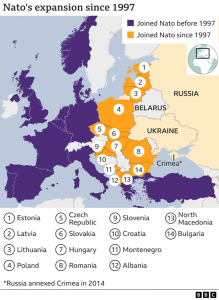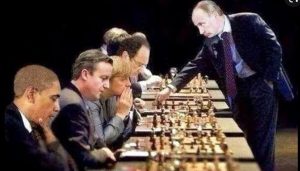Nato has rejected calls to enforce a no-fly zone, saying it could lead to direct conflict with Russia.
Nato member states such as Britain are already sending weapons to help Ukraine fight the Russian invasion. The EU says it will provide hundreds of millions of pounds to help arm Ukraine.
Russia has put its nuclear forces on “special alert” to counter what it calls Nato’s aggression.
What is Nato?
Nato – the North Atlantic Treaty Organization – is a military alliance formed in 1949 by 12 countries, including the US, Canada, the UK and France.
Members agree to come to one another’s aid in the event of an armed attack against any one member state.
Its aim was originally to counter the threat of post-war Russian expansion in Europe.
In 1955 Soviet Russia responded to Nato by creating its own military alliance of eastern European communist countries, called the Warsaw Pact.
Following the collapse of the Soviet Union in 1991, a number of former Warsaw Pact countries switched sides and became Nato members. The alliance now has 30 members.
Why is Nato not intervening?
Ukraine is not a member of Nato, so the alliance is not obliged to come to its defence.
It is only a “partner” country, meaning there is an understanding it might join at some point in the future.
Nato countries have also made it plain that if their troops were to confront Russian forces in Ukraine, it could lead to an all-out conflict between Russia and the west.
US President Joe Biden has said: “That’s a world war when Americans and Russia start shooting at one another.”
Will Nato impose a no-fly zone?
Nato has also rejected imposing a no-fly zone over Ukraine, to deny Russia air superiority and protect civilians.
One reason is that it wants to avoid conflict between Russian and its air forces. Another reason is that Nato planes, which are trying to protect themselves from attack, might need to fire anti-radiation missiles (ARMs) at radar installations on Russian territory.
Russia could use this as a reason to declare war on Nato countries.
How is the West helping Ukraine indirectly?
Some Nato nations have been sending weapons to Ukraine to help its defend itself against Russia.
The US sent weapons $200m (£149m) to Ukraine, including Javelin anti-tank missiles and Stinger anti-aircraft missiles, and allowed other Nato countries to supply Ukraine with US-made weapons. It says it will now send an extra $350m (£261m) in weapons including Javelin anti-tank missiles, anti-aircraft systems and body armour.
Britain has sent 2,000 short-range anti-tank missiles and says it will send more weapons in the future.
Germany is sending 1,000 anti-tank weapons and 500 Stinger missiles. It has also dropped some restrictions on other countries sending German-made weapons to Ukraine.
The Netherlands is sending 200 anti-aircraft missiles. Belgium is sending 2,000 machine guns and fuel. Sweden is sending 5,000 anti-tank weapons, helmets, body armour and rations.
Nato has stepped up its military defences in eastern Europe
Poland has started sending ammunition, while Estonia and Latvia have begun to send fuel, anti-tank weapons and medical supplies. The Czech Republic has said it will send guns and ammunition. Slovakia has said it will send ammunition and fuel.
The EU has said it will be spending up to 450m euros (£376m) to fund the supply of weapons to Ukraine. It’s the first time in its history the EU has helped provide arms for a warzone.
One of Russia’s demands before the invasion was that Ukraine should never be allowed to join – something the alliance refused to agree to.
Russia fears Nato has been encroaching on its territory by taking on new members in eastern Europe and that admitting Ukraine would bring Nato forces into its backyard.
Nato says it is a purely defensive alliance. Its secretary-general, Jens Stoltenberg, condemned Russia’s invasion of Ukraine as a “brutal act of war”.
What presence does Nato have in Eastern Europe?
Nato already has troops stretching from the Baltic republics in the north to Romania in the south.
They were stationed there in 2014 after Russia’s annexation of Crimea and are designed to act as a “tripwire” in case of a Russian attack.
Russia’s invasion of Ukraine has heightened concerns among members in eastern Europe.
Nato is now deploying elements of its 40,000-strong Response Force to Eastern European countries bordering Russia and Ukraine.
It has 100 fighter jets on high alert and has 120 ships, including three carrier groups, patrolling the seas from the far north to the eastern Mediterranean.
“We will defend every ally and every inch of Nato territory,” said Mr Stoltenberg.
President Putin of Russia has put the country’s nuclear forces onto “special alert” because of “aggressive statements” by the West.
The announcement does not mean Russia intends to use the weapons.
The US immediately condemned his decision calling it an “unacceptable escalation”.
The US has committed to sending more troops to Europe, but President Biden said they will not be fighting in Ukraine itself.
The extra troops will join the four multinational battlegroups Nato has in Estonia, Latvia, Lithuania and Poland, and its multinational brigade in Romania.
https://www.bbc.com/news/world-europe-18023383
BBC-
Ramin Sarajari Comment: It is well known that the Kremlin’s ambition is to recreate a sphere of influence and get back to the old USSR map. And deny other countries the right to choose their own path. But what could the west give to Russia to ease their mind and why they did not do anything about it?! It seems that behind the curtain there are other hidden agenda. Nevertheless, this is a disaster and its going to create more challenges in years down the road. After all, the nuclear power Russia is playing the chess game very well and the west is in a situation that has no option but accepting losing some countries to the Russia ( Putin).
Ramin Sarajari


